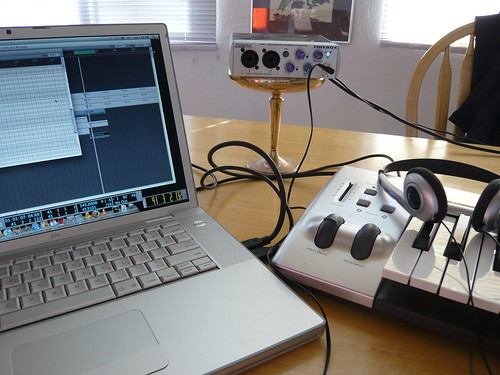 April 12, 2012
April 12, 2012 Is it Possible to Build a Portable Recording Studio For Less Than £250?
When pro audio gear reached the masses seven or eight years ago, the ‘home studio’ dream was born for tens of thousands of musicians all around the world. A couple of years later many of the leading manufacturers of recording gear such as Mackie and Motu started catering to the nomadic musicians and the touring artist with portable gear.

A few days ago I was asked a question that got me thinking, the question was “if you only had £250 to set up a studio that was portable but beyond demo quality, what would you spend it on?” I did some browsing and came up with a possible solution.
First of all, I’m assuming that you already have a laptop, so I won’t include that in the price. I will also clarify that £250 is an incredibly low budget for this kind of operation, but I think it is possibly nowadays to build a reasonably good quality basic setup on this budget (just about)! Studio gear is also a very personal preference, so you may have had bad experiences with some of the gear i’ve suggested - if so, share them in the comments as I’d be keen to hear similar good alternatives that I haven’t considered.
The Software & Interface
A good sequencer and interface is the heart of your setup, so it pays to get this one right. Most sequencers offer a free limited special edition version, which often comes free with recording equipment, such as microphones. While there are several completely free options available like Audacity and Garageband, using a professional solution like Cubase, Logic, or Pro Tools is a wise foundation to build upon.
This essential recording studio package from Pro Tools and M Audio is just under £50 and includes Pro Tools software and a sufficiently high quality interface to connect your instrument or microphone to the computer with. If you need to upgrade to a 2-track interface, there is also a 2-track model available for just £15 extra.
The Microphone
Depending on what you’re recording, you’ll most likely want a good condenser microphone to record vocals, and possibly guitars. Although the M-audio / Pro Tools pre amp does feature an XLR input for microphone, I’d recommend a good USB microphone such as the Blue Yeti or Snowball, both of which cost less than £75
The Headphones
You probably won’t have the luxury of being able to carry a good set of studio monitors around with you as a part of your portable studio, so it’s important to invest in a good set of headphones. To compensate for the lack of a pair of accurate sounding speakers, you may want to go for the industry standard Beyerdynamic DT-100s, which retail for around £100. However, AKG and Sennheiser both offer reasonable quality studio headphones for under £30 (the AKG K44s, and the Sennheiser HD 201s).
The Midi Controller
If you’re doing any kind of electronic music programming, you’re going to want a midi controler. Although there are a range of ‘roll up midi keyboards’ designed for portability, I’d recommend going for an inexpensive small 25-key midi keyboard with a sufficient velocity control. The M-audio Oxygen 25 or the Alesis Q25 are both good options around £50. If you are using midi, remember to set aside an extra £20 or so for a USB midi interface.
Conclusion
Although this setup is incredibly basic, it’ll fit in a backpack and sufficiently be able to record and program your music while you’re on the go all for less than £250. Here’s the breakdown:
- Pro Tools / M-audio Software & Interface = £49
- Blue Snowball USB Condensor Microphone = £57
- AKG K44 Closed Headphones = £21
- M-audio Oxygen 25 Midi Controller = £56
The total cost is £183, leaving a good £80 left over to invest in your favourite plugins or samples, both of which can be picked up for cheap second-hand on eBay. So there you have it, a fully functional and reasonably good quality portable recording studio for under £250. What would you buy if you had that budget to spend on creating a portable studio?
 recording,
recording,  studio | tagged
studio | tagged  DIY,
DIY,  recording,
recording,  recording studio
recording studio 





Reader Comments